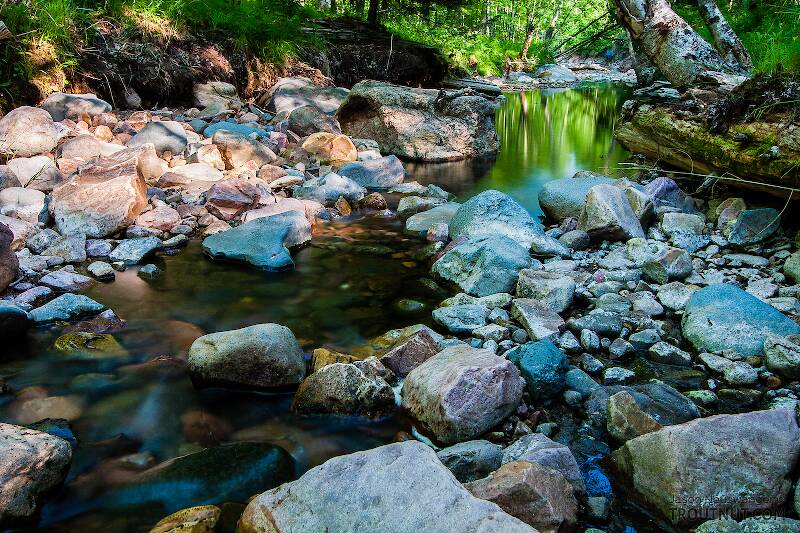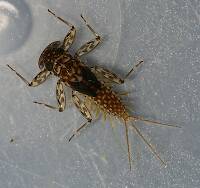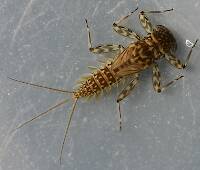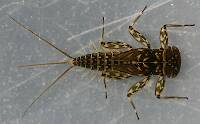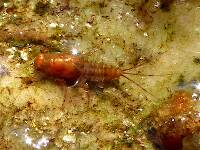
Salmonflies
Pteronarcys californica
The giant Salmonflies of the Western mountains are legendary for their proclivity to elicit consistent dry-fly action and ferocious strikes.
Featured on the forum

This one pretty clearly keys to Kogotus, but it also looks fairly different from specimens I caught in the same creek about a month later in the year. With only one species of the genus known in Washington, I'm not sure about the answer to this ID.

Troutnut is a project started in 2003 by salmonid ecologist Jason "Troutnut" Neuswanger to help anglers and
fly tyers unabashedly embrace the entomological side of the sport. Learn more about Troutnut or
support the project for an enhanced experience here.
Entoman on Mar 22, 2012March 22nd, 2012, 9:48 am EDT
Now those are cool flies!!!
"It's not that I find fishing so important, it's just that I find all other endeavors of Man equally unimportant... And not nearly as much fun!" Robert Traver, Anatomy of a Fisherman
PaulRoberts on Mar 22, 2012March 22nd, 2012, 1:02 pm EDT
Fun!
There's a cool shot of a subvaria emerging Jason caught from below:
http://www.troutnut.com/hatch/1711/Caddisfly-Brachycentridae-Apple-Caddis-and-Grannoms
It's a Brachycentrus thread, but scroll down and there is a subvaria emerging amidst some Grannom shucks.
There's a cool shot of a subvaria emerging Jason caught from below:
http://www.troutnut.com/hatch/1711/Caddisfly-Brachycentridae-Apple-Caddis-and-Grannoms
It's a Brachycentrus thread, but scroll down and there is a subvaria emerging amidst some Grannom shucks.
Wiflyfisher on Mar 22, 2012March 22nd, 2012, 3:12 pm EDT
This video re-confirms my thinking for how the emerger pattern should look...
http://vimeo.com/36206088
Have you bug nuts seen the Ralph Cutter's DVD Bugs of the Underworld?
http://vimeo.com/36206088
Have you bug nuts seen the Ralph Cutter's DVD Bugs of the Underworld?
John S.
https://WiFlyFisher.com
https://WiFlyFisher.com
Martinlf on Mar 22, 2012March 22nd, 2012, 6:19 pm EDT
John, I like that pattern and your creativity. I'm fond of the Klinkhamer style emergers, but this year for olives I also used a straight hook version modeled on a Borger yarn wing dun that worked very well. Your pattern looks like it in some ways, and also like Weamer's Truform flies, with the upward bend in the hook shank. Weamer, you may know, puts a parachute hackle underneath. Your approach looks much simpler and quicker. BTW as you will recall, Lloyd also bends his hooks, though mostly for nymphs, if memory serves me. What hook are you bending there? It looks like a Mustad. Anyway, thanks for the ideas.
"He spread them a yard and a half. 'And every one that got away is this big.'"
--Fred Chappell
--Fred Chappell
Wiflyfisher on Mar 22, 2012March 22nd, 2012, 6:33 pm EDT
Louis, I know others have used bent up hooks before. The Klinkhamer style does work but I feel the silhouette is wrong, especially the wing sticking straight up in the air.
I am using Mustad and TMC. So far only the Mustad have I had any breakage while bending the hook. I thought about parachute style too but I think it's too time consuming and I feel it adds too much extra hackle on the water.
I posted details on my blog a few days ago... http://flypatternsfortrout.com/2012/03/10/making-a-more-natural-looking-emerger-dun-mayfly-pattern/
I am using Mustad and TMC. So far only the Mustad have I had any breakage while bending the hook. I thought about parachute style too but I think it's too time consuming and I feel it adds too much extra hackle on the water.
I posted details on my blog a few days ago... http://flypatternsfortrout.com/2012/03/10/making-a-more-natural-looking-emerger-dun-mayfly-pattern/
John S.
https://WiFlyFisher.com
https://WiFlyFisher.com
Entoman on Mar 22, 2012March 22nd, 2012, 6:51 pm EDT
John -
I've observed most mayfly surface emergence is a two stage affair in a sense. The first part is when the dun is just beginning to emerge when the nymph is hanging down. As the dun emerges further the nymph body lifts up against the underside of the film. When the dun is almost escaped (usually with one or both wings out) the nymphal husk is trailing behind horizontaly - sometimes just under, sometimes in the film.
Yes, it's very well done. I especially liked the midge section. It certainly shows why the common pupa designs often fail when fished in the surface film. It motivated me to work on a tiny chinook helicopter design to imitate the behavior (They're right up your alley, Tony:)). I haven't fished stillwaters as much the last few years and so haven't run into enough hatches (that my experiments matched) to conclude anything. The few times I did, the results were very promising. Durability is an issue (the back hackle gets pretty worked over because it's tied conventionally deep into the bend almost parallel with the point. They're also a pain in the ass to tie.:)
This video re-confirms my thinking for how the emerger pattern should look...
I've observed most mayfly surface emergence is a two stage affair in a sense. The first part is when the dun is just beginning to emerge when the nymph is hanging down. As the dun emerges further the nymph body lifts up against the underside of the film. When the dun is almost escaped (usually with one or both wings out) the nymphal husk is trailing behind horizontaly - sometimes just under, sometimes in the film.
Have you bug nuts seen the Ralph Cutter's DVD Bugs of the Underworld?
Yes, it's very well done. I especially liked the midge section. It certainly shows why the common pupa designs often fail when fished in the surface film. It motivated me to work on a tiny chinook helicopter design to imitate the behavior (They're right up your alley, Tony:)). I haven't fished stillwaters as much the last few years and so haven't run into enough hatches (that my experiments matched) to conclude anything. The few times I did, the results were very promising. Durability is an issue (the back hackle gets pretty worked over because it's tied conventionally deep into the bend almost parallel with the point. They're also a pain in the ass to tie.:)
"It's not that I find fishing so important, it's just that I find all other endeavors of Man equally unimportant... And not nearly as much fun!" Robert Traver, Anatomy of a Fisherman
Wiflyfisher on Mar 22, 2012March 22nd, 2012, 7:15 pm EDT
As the dun emerges further the nymph body lifts up against the underside of the film. When the dun is almost escaped (usually with one or both wings out) the nymphal husk is trailing behind horizontaly - sometimes just under, sometimes in the film.
That is exactly the transition state I am trying to imitate.
John S.
https://WiFlyFisher.com
https://WiFlyFisher.com
Crepuscular on Mar 23, 2012March 23rd, 2012, 8:23 am EDT
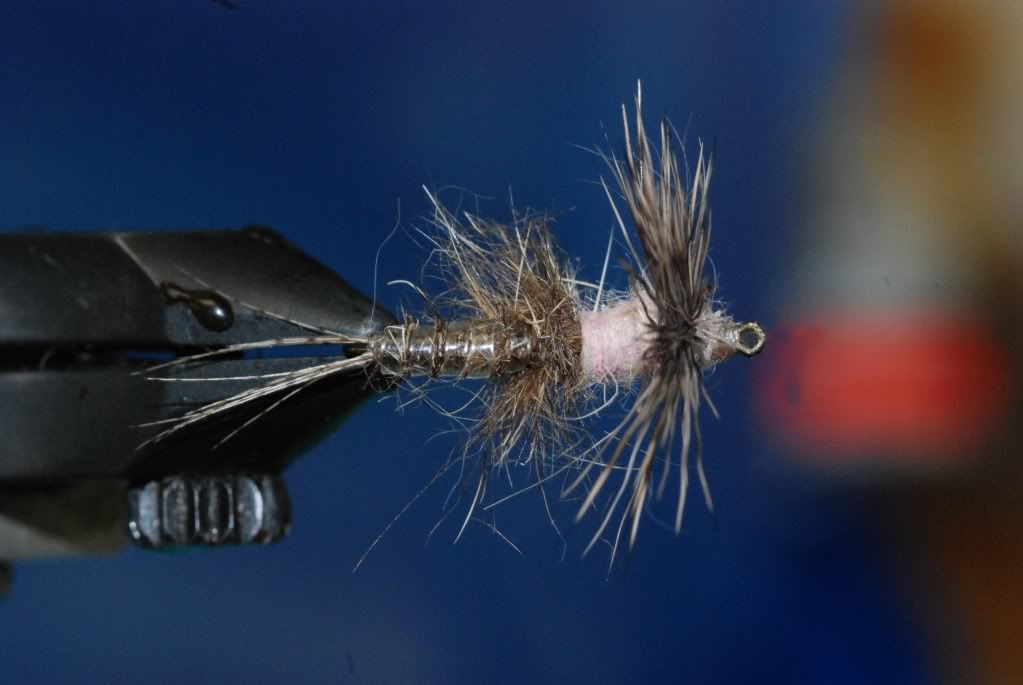

It looks we are on the same page! These photos are a pattern I started tying a couple years ago. It is a prototype that I have since modified. But I don't have any photos of those right now. Now tie basically the same pattern but sometimes use a CDC wing and hackle tied thorax style and clipped on the bottom a la Marinaro
Entoman on Mar 23, 2012March 23rd, 2012, 11:18 am EDT
That is exactly the transition state I am trying to imitate.
Yes I noticed, John. In my opinion you are doing a hell of a job of it.
Another cool fly, Eric. At the early stage when the nymphal shuck is still that opaque and the dun body is just starting to exude, I've had better luck with the wings still tucked and more Clinkhammer style. When they are horizontal with their wings out, I've noticed a difference if the dun body is longer and the shuck is more translucent.
Guys, some anglers may think we are nitpicking these various stages of emergence, but it does make a difference. Since both stages of the transition are usually only measured in seconds, you wouldn't think the trout would care. But they do - and often enough that it's worth carrying both styles.
"It's not that I find fishing so important, it's just that I find all other endeavors of Man equally unimportant... And not nearly as much fun!" Robert Traver, Anatomy of a Fisherman
Wiflyfisher on Mar 23, 2012March 23rd, 2012, 11:54 am EDT
Guys, some anglers may think we are nitpicking these various stages of emergence, but it does make a difference. Since both stages of the transition are usually only measured in seconds, you wouldn't think the trout would care. But they do - and often enough that it's worth carrying both styles.
When the hatch gets heavy after a few days they can get very selective and not all trout are zeroed in on the same transition stage. What works on one may not on the next fish.
I am always amazed how nitpicky you need to be during some of the hatches on the Henry's Fork. Those rainbows give new meaning to selectivity.
John S.
https://WiFlyFisher.com
https://WiFlyFisher.com
Entoman on Mar 23, 2012March 23rd, 2012, 5:32 pm EDT
Henry's Fork? So you've spent a lot of time there? I thought you're profile photo looked like a pretty wide expanse of water for WI...:)
"It's not that I find fishing so important, it's just that I find all other endeavors of Man equally unimportant... And not nearly as much fun!" Robert Traver, Anatomy of a Fisherman
Wiflyfisher on Mar 23, 2012March 23rd, 2012, 6:02 pm EDT
Henry's Fork? So you've spent a lot of time there? I thought you're profile photo looked like a pretty wide expanse of water for WI...:)
Kurt, that is a WI river. I love the Henry's Fork! I have a close friend who is retired out there. I could spend all season out there. I like small flies and finicky wild trout that can greyhound you.
http://www.youtube.com/watch?gl=US&hl=en&client=mv-google&v=01ww0-IjD1s
John S.
https://WiFlyFisher.com
https://WiFlyFisher.com
Quick Reply
Related Discussions
Topic
Replies
Last Reply
1
Aug 21, 2007
by Gene
by Gene
4
Sep 27, 2014
by Millcreek
by Millcreek
4
Apr 21, 2007
by PeterO
by PeterO

